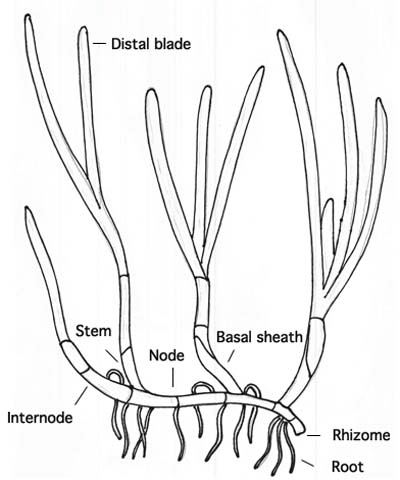Biomass and productivity vary latitudinally, being greatest in tropical waters. The Mediterranean basin used to be hypersaline, so it seems only natural the sea-grasses should have inherited it. The major polyhaline species can handle a wide range of salinities, but only the Halophila spp., are truly marine.
Sea-grass meadows as a food source
Few animals appear to directly rely upon sea-grass production as a food source, although some fish, turtles, sirenians and sea-urchins with ruminant-like cultures of cellulose-splitting bacteria in their guts are noticable exceptions. Most consumers however are dependent upon the decomposing grasses, and bacteria and fungi are critical in rendering plant material digestible. Aged sea-grass is assimilated much more than artificial detritus.Sea-grass detritus is rich in micro-organisms, and one gram supports on average 10^9 bacteria, 5 x 10^7 heterotrophic flagellates and 10^5 ciliates. Living sea-grasses also provide an attachment site for epiphytic algae both macroscopic and unicellular,a nd other algae occur between the shoots and in surface sediment layers. The benthic algae may actually account for 70% of the total primary production recorded, but thick carpets of leaves reduce the light intensity reaching the benthic flora.
Species
Zostera marina: These have a rhizome root system and reproduce vegetatively, growing from the dead, older shoots.
Halodue beaudettei: This shoal grass is found in deeper waters, and creates a boundary layer effect. It has a broader surface area to absorb more light and resist against strong currents.
Halophila decipiens: Paddle grass.
Syringodium filiforme: Manatee grass.
Posidonia oceanica: Characteristic of the Mediterranean; P. australis is only found in Australia.
Thalassia testudinium: Turtle grass.
Biology
They have strap-like, flattened leaves, with blades, an extensive root and rhizome system. They have no stomata, being underwater, so do not worry about water loss; for the same reason they also have thin cuticles. Sea-grasses also have large, thin-walled Aerenchyma tissue, which is used for gas exchange and buoyancy. Lacunae are continuous channels used for gas transport to the roots, and the roots themselves have hairs to increase surface area. They are halophytic (salt-tolerant), and can obtain nutrients from the sediment and water column through roots and leaves.

Associated fauna:
Sea-grass is extremely important for conservation purposes, being the key food source for sea turtles, parrot fish, surgeonfish, sea urchins, the queen conch, manatees and dugongs. Sea-grass ecosystems are usually surrounded by nutrient-poor waters to concentrate this effect, and over-fishing of the Queen Conch (Strombus gigas), which are epiphyte grazers, threatens the balance of the whole system.
The Sirenia order include the Trichechus manatus and Dugong dugon, and these sea cows rip out the root system of the sea grass they graze, causing pernament damage and placing pressure on the sea-grass bed. Sea-grass is also vulnerable to storm damage on top of excessive grazing, alongside dredging, boat damage, pollution and wasting disease.
No comments:
Post a Comment